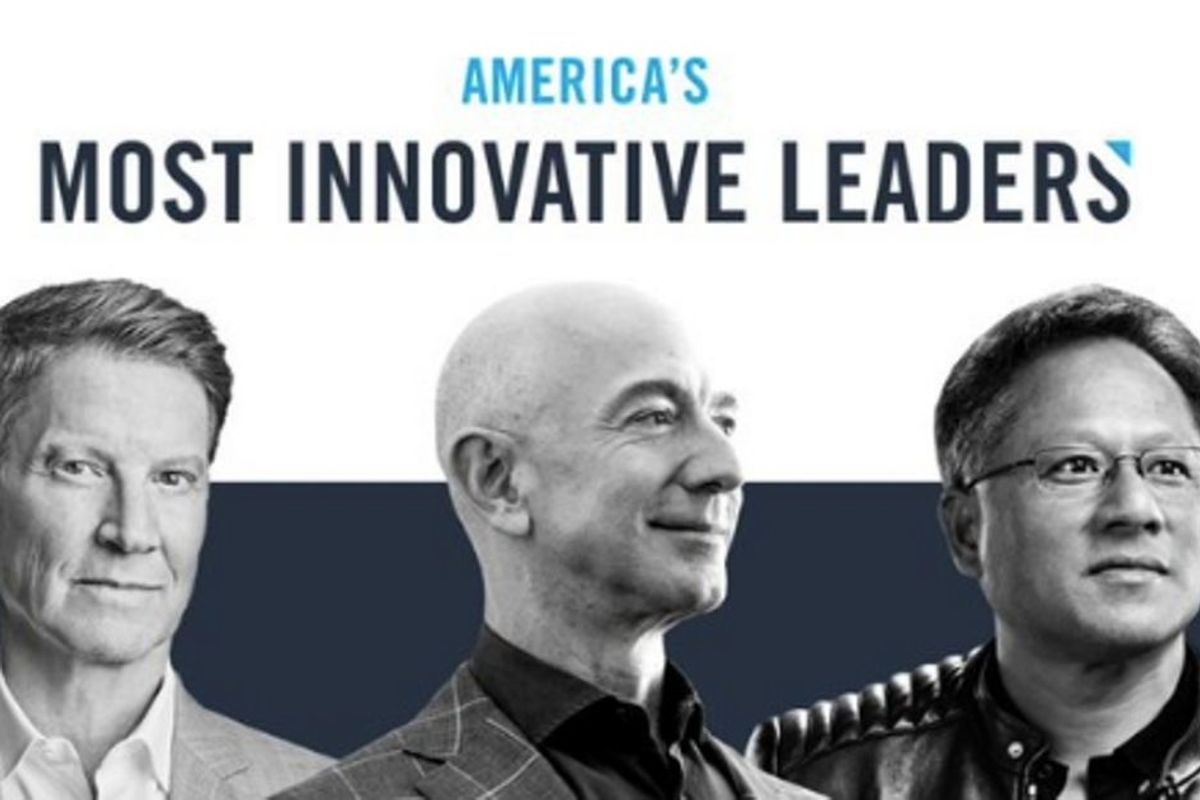Forbes' 100 Most Innovative Leaders list includes 99 men. Here's how their methodology was flawed
Come on, guys.

The fine folks at Forbes are currently falling all over themselves trying to clean up the mess they created by publishing their 2019 list of 100 Most Innovative Leaders.
The problem: The list included 99 men and one woman. For those not so good with the math, that means according to Forbes, only 1% of the country's most innovative leaders are female.
Have you ever watched a movie that's so abysmally bad that you wonder how it ever even got made? Where you think, "Hundreds and hundreds of people had to have been directly involved in the production of this film. Did any of them ever think to say, 'Hey, maybe we should just scrap this idea altogether?"
That's how it feels to see a list like this. So how did Forbes come up with these results?
Let's start with the description at the top of the published list, synopsizing who compiled the list and how:
"Business school professors Jeff Dyer, Nathan Furr and Mike Hendron teamed up with consultant Curtis Lefrandt to measure four essential leadership qualities of top founders and CEOs: media reputation for innovation, social connections, track record for value creation and investor expectations for value creation. The researchers then ranked these visionaries in a high-powered selection of 100 innovators at top U.S. companies."
So right off the bat, we have four men in the business world deciding on the criteria for what makes an innovative leader. There's no way those men could have some biases they aren't aware of, right?
Perhaps that's not a fair assumption on its face, but when a list those men compile includes 99 men and one lone woman? Yeah, I'm gonna go with bias, conscious or unconscious.
Then we have the four criteria they used. Hoo boy. Here's where it becomes painfully obvious to anyone with an inkling of gender equality dynamics and an ability to do a Google search why only one woman ended up on their list.
RELATED: Women make better leaders despite lack of representation, study finds
Let's take a look at the criteria, which you can read about more here, one by one:
1) Media reputation for innovation
Yes, let's uses media reputation as criteria when women are famously underrepresented in the media.
As the Harvard Business Review reports, "Around the world, women are far less likely than men to be seen in the media. As subjects of stories, women only appear in a quarter of television, radio, and print news. In a 2015 report, women made up a mere 19% of experts featured in news stories and 37% of reporters telling stories globally."
We already know that women are underrepresented in top business leadership positions. Combine that fact with women being underrepresented in the media, and this one criteria alone already puts women at a disadvantage.
Next...
2) Social connections/Social capital
Umm, has no one at Forbes ever heard of the "good old boys" network? Are they unaware of the tendency for the historical wealth and power held by men to perpetuate because of men's "social connections" and "social capital" with one another?
How many business meetings are conducted at "gentlemen's clubs"? Cigars after dinner? Golf, anyone?
Of course Forbes know about this. They've even published articles about it.
Let's tack on the fact that the second most powerful leader in our nation won't meet with a woman without a chaperone, but has no problem meeting with a man alone.
Yeah. Those social "connections" and "capital" are sometimes generations deep and pretty obviously limited for women in multiple ways.
3) Track record of market value creation at the company they lead
This is a bit stickier of a criteria to examine, mainly because it seems like a pretty straight-forward data point. But when we break down what it takes for a company to create market value, it starts with funding to get the company off the ground to begin with.
And guess what—women receive far, far less venture capital than men do.
Wharton School of Management professor Ethan Mollick says that 38% to 40% of all U.S. startups have female cofounders, and 40% of companies are funded by venture capitalists. But those numbers don't overlap. Only 2% to 4% of VC funded companies have female cofounders.
"There are a bunch of reasons," says Mollick, "but one key reason seems to be — and this is a problem that we see in discrimination everywhere — something we call 'homophily.' It's the principle that 'birds of a feather flock together.' People like people like themselves. VCs tend to be mostly male; they have friend networks that are mostly male. As a result, you have a very strong network of men who talk to each other, and it's very hard for a woman to get access to these people."
"It doesn't matter how proactive and feminist you are as a guy," he continues. "If the network you are part of is mostly men, you're just not going to see as many women's projects, you're not going to hear in your network about as many successful women. You're not going to be able to do due diligence as easily. This has been a problem in a lot of fields."
So again, women are at a disadvantage on this criteria from the starting line—and it has nothing to do with how innovative they are.
RELATED: 11 facts about women-run businesses that prove the future really is female.
4) Investor expectations of future growth and innovation at their firm
You can probably guess by now what kinds of expectations investors (who we already know are primarily male) have of the future of women's businesses. But let's look at some data anyway.
Columbia University doctoral fellow Dana Kanze conducted a study on pitch competitions, where aspiring entrepreneurs attempt to convince investors to support their business ideas. Interestingly, her team found that investors ask men and women different kinds of questions—and those differences can affect how they view their likelihood of success, and therefore, their "expectations of future growth."
As Inc.com reports:
"Kanze and her team, which includes Laura Huang of Harvard Business School and Mark Conley and E. Tory Higgins of Columbia, dissected the video of 189 company presentations at TechCrunch Disrupt from 2010 to 2016. They found that 67 percent of the questions posed to male entrepreneurs were so-called promotion questions, on subjects such as the total addressable market. By contrast, some 66 percent of the questions asked of female entrepreneurs were prevention-focused: How to defend market share or protect intellectual property, for instance.
The entrepreneurs, not surprisingly, reacted in kind. Ask a guy how big his market is, and, not surprisingly, he'll tell you. Ask a woman how she'll defend her market share, and she'll answer. But the net result is that the women end up looking like they're playing defense, while the men end up looking like the ones with the big visions who are going to change the world. 'You're going to walk away from that conversation thinking the women just care about not losing money,' Kanze says. Her research found that for every additional prevention question an entrepreneur is asked, he or she raised $3.8 million less in aggregate funding."
The difference in questioning is subtle and unconscious. "No one is sitting there saying, 'Hey, you asked him different questions,' Kanze says. "This is the cycle of bias we are trying to break."
And it is this "cycle of bias" that is the entire problem with the methodology used to create the Forbes list. How all of this slipped past the folks responsible for it is baffling, but also a clear example of the problem—men in the business world are so deep in the pool they can't see the obstacles that keep others out of it.
What I can't figure out is how the final list was ever allowed to go to publication. I mean, this is 2019. Everyone is aware of bias at this point. As soon as the numbers were crunched, the data was aggregated, and the results came back with 99 men and one woman, a red flag should have waved in front of the face of everyone involved.
Moira Forbes, a fourth generation Forbes family member—and the first female to be part of the company (ahem)—expressed that she was "disheartened" to read the list, acknowledged that criticisms were warranted, and said she shared many of the same sentiments as those who have complained.
Forbes editor-in-chief Randall Lane wrote a "reflection" on the lack of women on the list, acknowledging that there were flaws in the methodology but falling short of recognizing the full extent of what those were.
"Our methodology was flawed, as well—at a minimum when it came to being more expansive with who was eligible to be ranked. While each data point individually made logical sense, as did focusing on data-rich public companies, the entire exercise collapses if the possible ranking pool doesn't correlate at least somewhat with the overall pool of innovative talent. It would be intellectually dishonest to construct a methodology designed to generate a predetermined result, but in this case the forest got lost in the trees."
Here's the thing, though—each data point only "made logical sense" if you are looking through the lens of a male who is oblivious of how those data points filter out women. No one is looking to "generate a predetermined result." What we want is a methodology that actually measures innovation in a meaningful way and not with criteria that simply reinforce the workings and dynamics of the male-dominated business world.
TLDR: You should have known better, guys—if not from the start, from the moment the results came back so completely male-heavy. And that fact that you either didn't notice the gender discrepancy—or did, but didn't bother to reexamine the methodology before taking the list to publication—is the crux of the entire problem in the first place.



 Tony Trapani received the most important letter of his life, but he didn't see it for 50 years Photo by
Tony Trapani received the most important letter of his life, but he didn't see it for 50 years Photo by  Tony and Samuel didn't waste time thinking about what might have been if he'd seen the letter earlier. Photo by
Tony and Samuel didn't waste time thinking about what might have been if he'd seen the letter earlier. Photo by 



 Tickle Me Elmo changed Christmas as we know it in the 90s.Kevin Labianco/
Tickle Me Elmo changed Christmas as we know it in the 90s.Kevin Labianco/